Market to Market: Intelligent Promotions

The sheer size and scope of the booming technology market ensure there are promo opportunities for everybody.
The technology market is packed with buzzwords: augmented reality (AR), artificial intelligence (AI), blockchain. Only these words don’t paint a picture of futuristic ideas—they point to technology that is here now.
Companies’ use of AI has grown 270 percent over the past four years, according to Gartner. By 2022, the McKinsey Global Institute projects that the enterprise AI market will be worth $6.14 billion. In a shifting labor market, AI could add $13 trillion to the global economy by 2030.
From a sales and marketing standpoint, AI allows companies to deliver personalized experiences, gather better leads, evaluate business opportunities and drive more revenue. Venture Harbour reports that 61 percent of marketers say AI is the most important aspect of their strategy. By 2020, 30 percent of companies worldwide will use AI in at least one of their sales processes.
When it comes to email marketing and sales forecasting, 87 percent of AI adopters are using or considering using AI, according to Forbes. And here’s the real kicker—about half (49 percent) of consumers are willing to shop more frequently when AI is present, according to AI Trends, and 34 percent will spend more money.
The technology market is the 11th largest industry by sales of promotional products according to PPAI’s 2018 Sales Volume Study. It shares the spot with the entertainment industry and government with $816 million sold into each of these markets by distributors in 2018.
Promotional products can help companies bridge the gap between the physical and digital. You can’t touch an algorithm or taste a chatbot, but you can hold, feel and experience a promotional product in your hands. In a world of cutting-edge tech and innovations around every corner, promotional products give marketers a competitive advantage. They’re tangible reminders of a brand and everything that’s possible.
–––––––––––––––––––––––––––––––––––––––––––––––––––––––––––

Add a "wow" factor to your recognition program with the Hovington Portable Selfie Drone. Recipients can control this pocket-sized drone with their smartphone and shoot 720p photo and video through an app.
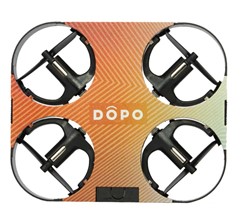
Origaudio / PPAI 421483, S7 / www.origaudiopromo.com
–––––––––––––––––––––––––––––––––––––––––––––––––––––––––––
With a lifetime guarantee, the Pelican G40 Go Case keeps brands around for the long haul. Designed with a co-molded protective bumper, a rugged integrated latch and a shock-proof cushioned interior, this case can stand up to any adventure.

Logomark, Inc. / PPAI 110898, S12 / www.logomark.com
–––––––––––––––––––––––––––––––––––––––––––––––––––––––––––
A fun way to personalize tech devices of all kinds, the EZ Mailer Tech Tattoo is printed in digital full color on white or clear vinyl. A smaller Tech Tattoo sheet conveniently fits in a standard #10 envelope.
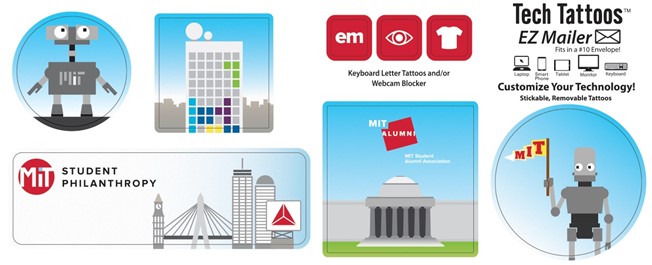
Gill Studios, Inc. / PPAI 114157, S11 / www.gill-line.com
–––––––––––––––––––––––––––––––––––––––––––––––––––––––––––
The accessories kit for Airpods makes a welcome gift that protects wireless earbuds while promoting your client’s brand. A silicone case offers scratch protection and a flexible silicone strap keeps earbuds around the user’s neck.

Leed’s / PPAI 112361, S13 / www.leedsworld.com
–––––––––––––––––––––––––––––––––––––––––––––––––––––––––––
Keep your logo visible on every commute with the cell phone magnetic air vent mount holder. Users simply place a magnetic disk on the back of their phone and push the holder into a car vent.
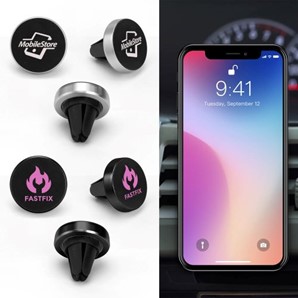
Webb Company / PPAI 143213, S7 / www.webbcompany.com
–––––––––––––––––––––––––––––––––––––––––––––––––––––––––––
Use the crystal cell phone holder to show gratitude to employees, clients or vendors. It’s gift-ready, packaged in a two-piece black gift box with die-cut foam.
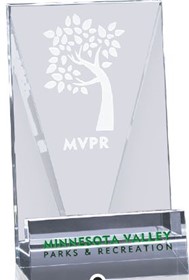
Crystal D / PPAI 112326, S6 / www.crystald.com
–––––––––––––––––––––––––––––––––––––––––––––––––––––––––––
Make a statement at tech conferences or trade shows with the Voyager Stylus – LaserMax. This metal ballpoint pen with an anodized aluminum barrel is offered in a variety of hues that match trending mobile device colors.
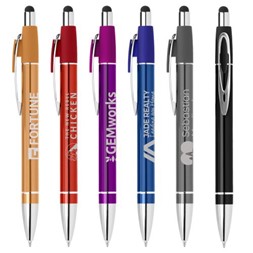
Goldstar / PPAI 114031, S7 / www.goldstarpens.com
–––––––––––––––––––––––––––––––––––––––––––––––––––––––––––

A retail technology store opened its doors in a mid-sized community. Each year, the city hosts a home improvement show where many local businesses operate a booth to meet members of the community and get some exposure. At the show, the store handed out the Powerplate Wireless Charging Pad. Show attendees were excited about the useful wireless charger. The store saw an uptick in store traffic for several months after attending the show and attribute the increase to the wireless charger it distributed.
Source: Beacon Promotions
–––––––––––––––––––––––––––––––––––––––––––––––––––––––––––

Executives at top-performing technology firms are significantly more likely than those at average-performing firms to:
- Regard their reward and recognition programs as a competitive advantage (twice as likely—86 percent vs 44 percent)
- Believe that rewards and recognition are a critical tool in managing the performance of the company (15 percent more likely)
- Strongly agree that their reward and recognition programs are effective recruitment tools (33 percent more likely)
Tech companies also take incentives and rewards seriously in these ways:
- Top-performing firms are 10 percent more likely than average firms to create “bottom up” budgets for incentives, calculating the appropriate investment as a percentage of the participant’s income
- Excluding incentive travel, top-performing technology firms invest $119 in non-cash rewards on an average per employee and $451 per top performer
- Top-performing technology firms spend $124 more on their top incentive travel rewards than average-performing firms do
- Top performers are 27 percent more likely to design and manage programs with strong collaboration among multiple departments (27 percent more likely)
- Top performers are more likely to structure their programs with the goal of reaching each participant versus only recognizing the top performers (22 percent more likely)
- Top performers are 25 percent more likely to use both reward points and twice as likely to use a group incentive trip
The most important requirement for classification as a top performer in this research was financial growth: more than five percent growth in revenue or stock price.
Source: Incentive Research Foundation
–––––––––––––––––––––––––––––––––––––––––––––––––––––––––––


Companies are forging into the future and embracing technology of all kinds. Nearly half (42 percent) of executives surveyed in Deloitte’s State of the Enterprise compendium say they believe AI will be of critical importance within two years. However, many of these companies face a talent shortage. One in five respondents says their organization lacks the skills of experienced AI software developers, data scientists, user-experience designers and change-management experts. More than half (54 percent) say the skills gap is the biggest challenge facing their organization. Forbes reports that the share of jobs requiring AI skills has grown 4.5 times since 2013.
Chatbots, those software applications that mimic conversations with a human, are also hot on the technology trail. By 2020, Innovation Enterprise predicts that chatbots will power 85 percent of all customer service. More than half (63 percent) of people already prefer messaging an online bot to communicate with a business or brand, according to Mindshare. Companies that use chatbots can significantly slash business expenses—savings could top $8 billion by 2022, according to Impactbnd.
AR is another fast-growing tech sector. In the future, shoppers will increasingly be able to get AI-based customer support while walking around a store. A chatbot can answer their questions about pricing, features or offers. Amazon currently gets 35 percent of its sales from its recommendation engine, which uses machine learning to deliver search results and match advertisers with customers, according to MobiDev. By 2023, the user base for AR products such as smart glasses will surpass 2.5 billion people, with the industry hitting $75 billion.

- The global public cloud computing market is set to reach $258 billion in 2019
- Organizations’ average yearly cloud budget was $2.2 million in 2018
- About a third of companies’ IT budget goes to cloud services
- The average business runs 38 percent of workloads in public and 41 percent in a private cloud
Source: HostingTribunal.com

Here’s how much some countries will spend on cloud computing this year:
- United States $124.6 billion
- China $10.5 billion
- United Kingdom $10 billion
- Germany $9.5 billion
- Japan $7.4 billion
Source: IDC

- Biocomputers: These computers use biological materials such as DNA and proteins to perform calculations involving data storage, retrieval and processing.
- Ambient working experience: Facilities such as conference rooms will identify users and provide assistant functionality and immersive collaboration experiences.
- Digital twin: A digital replica of a physical asset, process, system or service, a digital twin promotes understanding, identifies problems, develops new opportunities and helps plan for the future.
- Context aware computing: This kind of computing involves applications and services that take advantage of contextual data about a person or object to proactively anticipate the user’s needs.
- Smart contracts: These digital, peer-to-peer contracts are written into lines of programming code. They allow business rules agreed by the parties to be embedded across a distributed, decentralized network.
Source: Atos

- Artificial Intelligence
- Machine Learning
- Robotic Process Automation
- Blockchain
- Edge Computing
- Virtual Reality and Augmented Reality
- Cyber Security
- Internet of Things

- The AI market is projected to become a $190 billion industry by 2025
- 83 percent of early AI adopters have already achieved substantial (30 percent) or moderate (53 percent) benefits
- 63 percent of consumers believe AI will help solve complex problems that plague modern societies
- Global spending on cognitive and AI systems is expected to reach $57.6 billion in 2021
- By 2020, AI will eliminate 1.8 million jobs and create 2.3 million
- AI will boost profitability by 38 percent and generate $14 trillion of additional revenue by 2035
Sources: PWC, Deloitte, Markets and Markets, IDC, Venture Harbour, Accenture

By 2021, 10 percent of new vehicles will have autonomous driving capabilities, compared to one percent in 2017.
Source: ComputerWeekly.com

The global facial recognition market is worth an estimated $3.2 billion. By 2024, the market could generate $7 billion in revenue. The biggest drivers of growth include surveillance in the public sector, security and law enforcement, health, and marketing and retail.
Source: MarketsandMarkets

The global intelligent virtual assistant market topped $2.3 billion in 2018 and is projected to reach $19.6 billion globally by 2025. Growth is driven by increased usage of smart speakers, rising investments in smart homes and the Internet of Things (IoT).
Source: Zion Market Research

- Recruitment and retention. Tech companies face steep talent shortages now and that challenge is expected to continue.
- Promoting new technologies. Making innovative tech and tools available to clients and consumers, such as AI-based customer support.
- New product promotion. New product introductions can be more challenging for tech companies because of the complexities in design and use.
- Differentiation. There are more than 100,000 software and IT companies in the U.S. and 99 percent of them are small- and medium-sized firms (under 500 employees), so differentiation is of paramount importance.
–––––––––––––––––––––––––––––––––––––––––––––––––––––––––––
Audrey Sellers is a Dallas, Texas-area writer and former associate editor of PPB.

